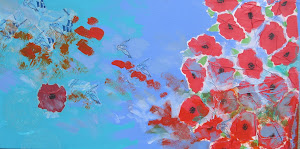For the past 3 weeks, the first graders have been working hard on these beautiful mixed-media landscapes. They learned so much during this unit, and practiced their collage skills!


The 1st graders started out by looking at various landscapes and noticing how the artists showed the land and sky in each picture. In each piece, there was no space between the sky and the ground! This helped everyone to realize that ground isn't just at the bottom, and sky isn't just at the top! Where one ends, the other begins - the sky and the ground appear to touch! The point where the ground and sky appear to touch is called the horizon line.


To be sure that the sky did in fact touch the ground in their landscape collages, students ripped 2 sheets of large 11x14 inch paper in half and glued the ripped pieces together to make their ground and sky. It was fun to see what shape the ground would take as it was ripped. As students got ready to choose their paper, we discussed all the different possibilities for ground and sky colors. For instance, sky at sunset can be red, pink or purple, sky on an overcast day looks white or gray, and a dark night sky or a sky full of storm clouds might appear black.


The next class period, students learned about distance in a landscape. The horizon line is the farthest away point on the ground that we can possibly see. I asked the students whether they thought something that far away would look big or little; the students weren't sure, so we did a little activity. First, we each held our hand really close to our face, and noticed how big it looked! Then, we slowly moved our hands away from our faces and noticed that our hand started to look smaller and smaller. The students concluded that something far away would look very, very small, and something closer up would look big. The students had to add details like plants and rocks to the ground. They were asked to make sure that they put some small ones near the horizon line and some big ones towards the bottom of the page to create the illusion of distance.


To finish their landscapes, students used crayons to add details, textures, and patterns to different parts of the land and sky. We had studied a variety of different environments and talked about their characteristics, so the students had plenty of ideas of what to add. Students also decided on their own to add animals and even depict different kinds of weather! Each and every student created their own interesting place full of unique details!


Will let you know when these go on display...!










.jpg)






















No comments:
Post a Comment